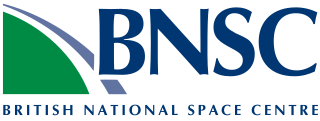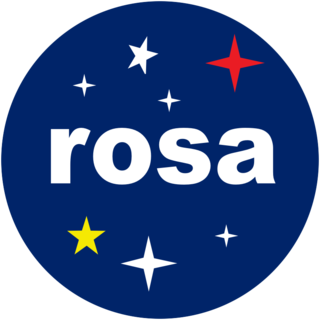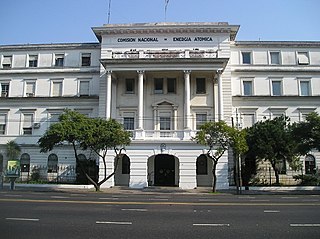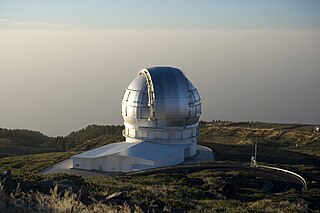
The European Space Agency is an intergovernmental organisation of 22 member states dedicated to the exploration of space. Established in 1975 and headquartered in Paris, ESA has a worldwide staff of about 2,200 in 2018 and an annual budget of about €7.2 billion in 2022.

The British National Space Centre (BNSC) was an agency of the Government of the United Kingdom, organised in 1985, that coordinated civil space activities for the United Kingdom. It was replaced on 1 April 2010 by the United Kingdom Space Agency (UKSA).

Pedro Francisco Duque Duque, OF, OMSE is a Spanish astronaut and aeronautics engineer who served as Minister of Science of the Government of Spain from 2018 to 2021. He was also Member of the Congress of Deputies from May 2019 until February 2020.

The Centre for the Development of Industrial Technology (CDTI) is a public organization for technology development in the Kingdom of Spain. In the Spanish language, the Centre is known as the Centro para el Desarrollo Tecnológico Industrial. It was part of the Ministry of Industry, Commerce and Tourism, later was part of Ministry of Science and Innovation and now it is part of the Ministry of Economy and Competitiveness. It claims to employ one hundred fifty people. The Centre supports companies that want to develop R&D projects with loans and other financial aids. In addition, provides technical support. The Centre has presence in Japan, the Kingdom of Belgium, the Federative Republic of Brazil, the Republic of Colombia, Korea, the Republic of Chile, and the Kingdom of Morocco. In 2002, the Centre contributed 117.2 million EUR to the European Space Agency.

The Instituto Nacional de Técnica Aeroespacial «Esteban Terradas» is an autonomous agency of the Spanish public administration dependent on the Secretariat of State for Defence (SEDEF). It is responsible for the aerospace, aeronautics, hydrodynamics, and defense and security technologies research.

The Framework Programmes for Research and Technological Development, also called Framework Programmes or abbreviated FP1 to FP9, are funding programmes created by the European Union/European Commission to support and foster research in the European Research Area (ERA). Starting in 2014, the funding programmes were named Horizon.

The Romanian Space Agency is a public institution with extra-budgetary funding which coordinates Romania's national space technology research programs and space research-related activities. ROSA was founded in 1991 and is subordinated to the Ministry of Education.

The most important aspects of science and technology in Argentina are concerned with medicine, nuclear physics, biotechnology, nanotechnology, space and rocket technology and several fields related to the country's main economic activities. According to the World Bank, Argentine exports in high-technology are products with high R&D intensity, such as in aerospace, computers, pharmaceuticals, scientific instruments, and electrical machinery. Benefiting from Latin America's highest literacy rates since shortly after President Domingo Faustino Sarmiento made primary education universally available in the 1860s and 1870s, Argentine researchers and professionals at home and abroad continue to enjoy a high standing in their fields. Argentine Bernardo Houssay was the first Latin American awarded with a Nobel Prize in sciences. Educated in a National University, Houssay went on to establish Argentina's National Research Council, a centerpiece in Argentine scientific and technological development, fifty years on. Many other Argentines have contributed to scientific development around the world, though sometimes having to emigrate to do so. Probably for that, the Argentine education is referred as the Latin American docta, which originates from the Latin docta (learned). Argentina was ranked 73rd in the Global Innovation Index in 2021.
ASCAMM Foundation is a Technology Center located near Barcelona, at the Vallès Technology Park. the origin of this Foundation was the Catalan Association of Enterprises Mould-Makers and Die-Makers, in Catalan: Associació Catalana d'Empreses constructores de Motlles i Matrius.

Cristina Garmendia y Mendizábal is a Spanish biologist and businesswoman. With no previous political career, she was appointed as Minister of Science and Innovation in April 2008 by the President of the Government of Spain, Jose Luis Rodriguez Zapatero.
Carlos Martínez Alonso, was born in Villasimpliz, in the province of León, on January 9, 1950. In 1974 he obtained a chemistry degree from the Universidad Complutense of Madrid. Four years later, in 1978, he obtained a Ph.D. in immunology by the same university. He was appointed President of the Spanish National Research Council (CSIC) from 2004 to 2008, and Secretary of State for Research in the Ministry of Science and Innovation from early 2008 to December 2009.
SEOSat-Ingenio, was a Spanish project to produce a satellite capable of providing wide-field imagery ensuring a repeat cycle of 38 days at 2.5 metre panchromatic resolution and 10 metre colour resolution, from a sun-synchronous polar orbit; it was Spain's first optical imaging satellite. The satellite was part of the Spanish Earth Observation Satellite program. The mission was funded by Spain's Centre for the Development of Industrial Technology (CDTI). SEOSat-Ingenio information was to be used by various Spanish civil, institutional or government users. However, under the Copernicus Programme of the European Union, it was also accessible to other European users, as well as to the Group on Earth observation of the Global Observing System of Earth.
Payload Aerospace S.L. is a Spanish company developing two partially-reusable launch vehicles called Miura 1 and Miura 5.

The Ministry of Science and Innovation (MICINN) is the department of the Government of Spain responsible for developing and implementing the government policy on scientific research, technological development and innovation in all sectors. In particular, MICINN is responsible for the exercise of research, technological development and innovation competencies in space matters, including representation and participation in European Union and International organizations.
The Secretary of State for Universities, Research, Development and Innovation was an official post of the Ministry of Science, Innovation and Universities of the Government of Spain that existed from 1977 to 2020. The Secretary of State was appointed by the King of Spain after being nominated by the Science Minister.

The Science Programme of the European Space Agency is a long-term programme of space science and space exploration missions. Managed by the agency's Directorate of Science, The programme funds the development, launch, and operation of missions led by European space agencies and institutions through generational campaigns. Horizon 2000, the programme's first campaign, facilitated the development of eight missions between 1985 and 1995 including four "cornerstone missions" – SOHO and Cluster II, XMM-Newton, Rosetta, and Herschel. Horizon 2000 Plus, the programme's second campaign, facilitated the development of Gaia, LISA Pathfinder, and BepiColombo between 1995 and 2005. The programme's current campaign since 2005, Cosmic Vision, has so far funded the development of ten missions including three flagship missions, JUICE, Athena, and LISA. The programme's upcoming fourth campaign, Voyage 2050, is currently being drafted. Collaboration with agencies and institutions outside of Europe occasionally occur in the Science Programme, including a collaboration with NASA on Cassini–Huygens and the CNSA on SMILE.
Alén Space is a Spanish company in the NewSpace sector, located in Vigo. Alén Space designs, constructs, and develops software and hardware for artificial satellites. Since 2008, the company builds nanosatellites below CubeSat requirements.
Spainsat NG is a Spanish communications satellite program aimed at developing next-generation satellites to meet Spain's government and military secure communications needs.

Science and technology in Spain relates to the set of policies, plans and programs carried out by the Spanish Ministry of Science and Innovation and other organizations aimed at research, development and innovation (R&D&I), as well as the reinforcement Spanish scientific and technological infrastructures and facilities such as universities and commercial laboratories. Spain has become the ninth scientific power in the world with 2.5% of the total number of scientific publications, thus surpassing Russia in the world ranking of scientific production and surpassing Switzerland and Australia in scientific quality.
The Agencia Espacial Española is a planned space agency of the Government of Spain that will be in charge of the Spanish space program. The agency was officially announced on 27 May 2021 and is expected to be operational in 2023.











